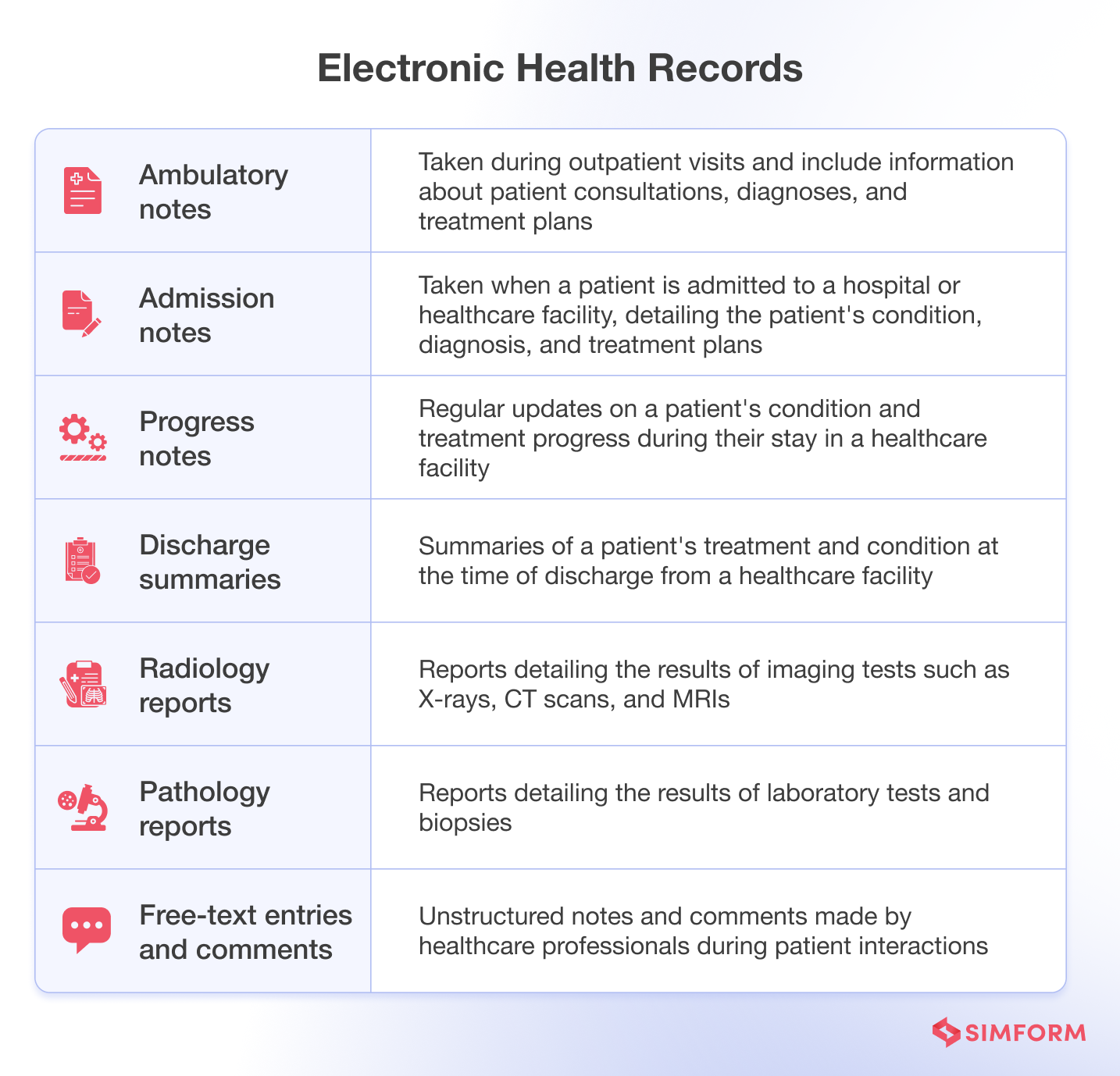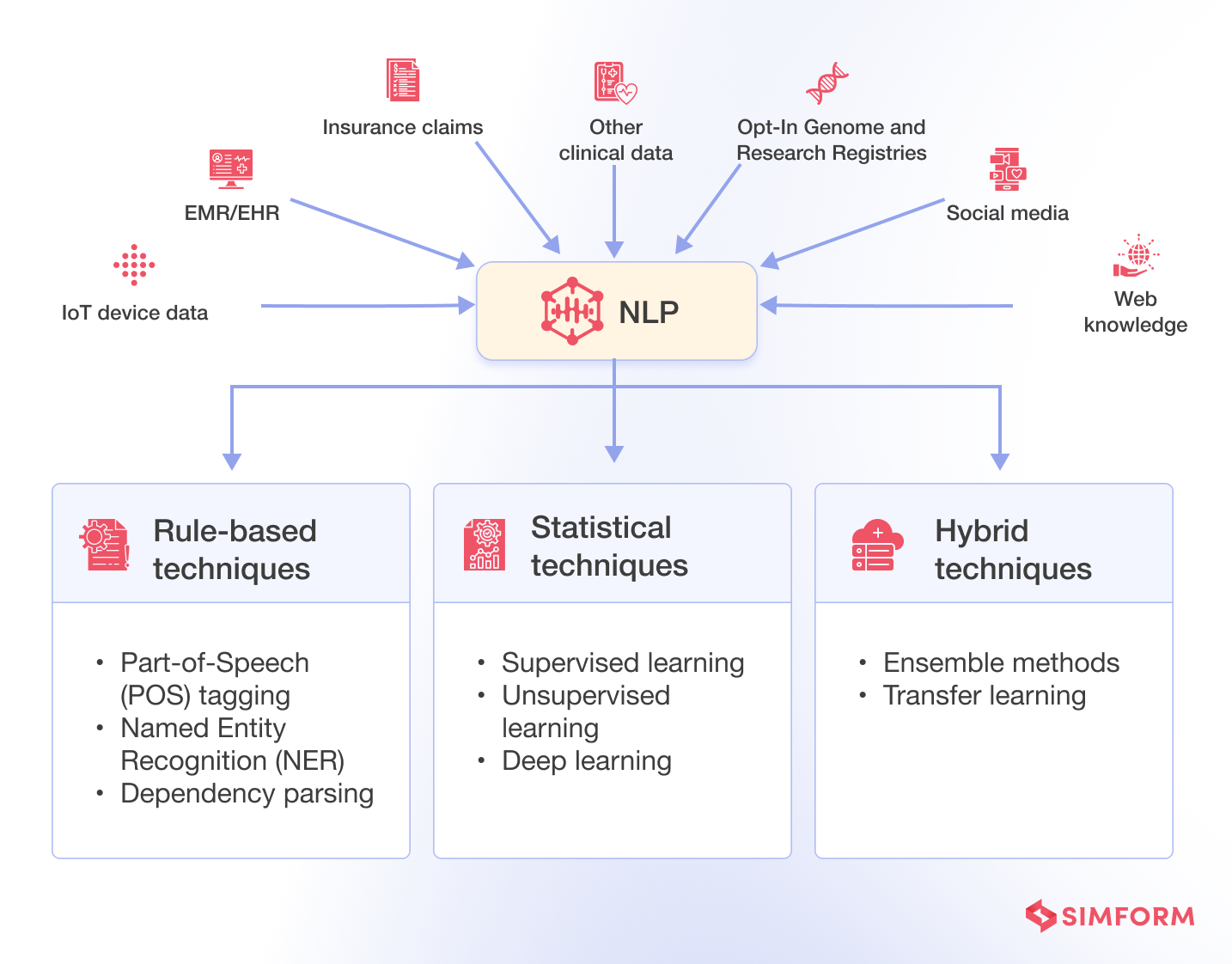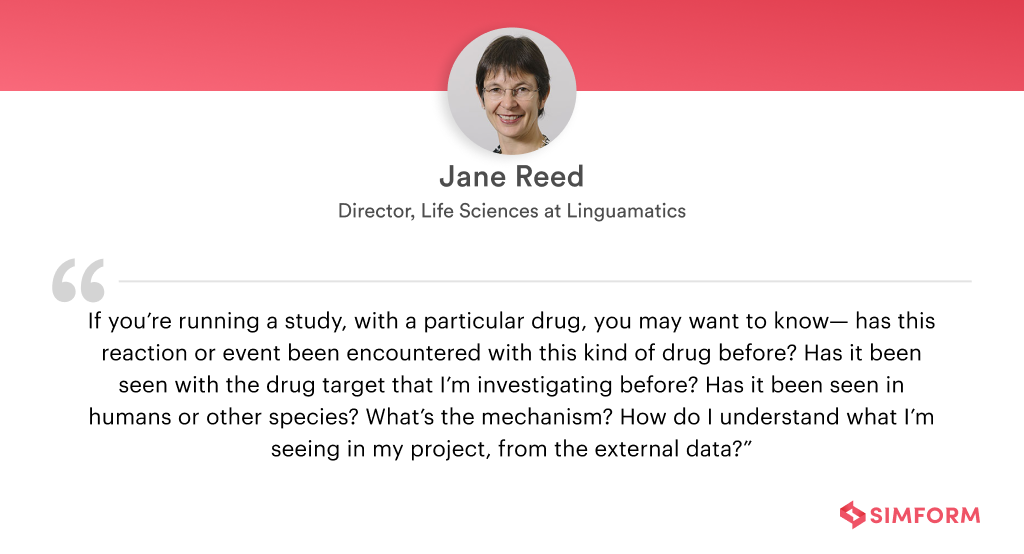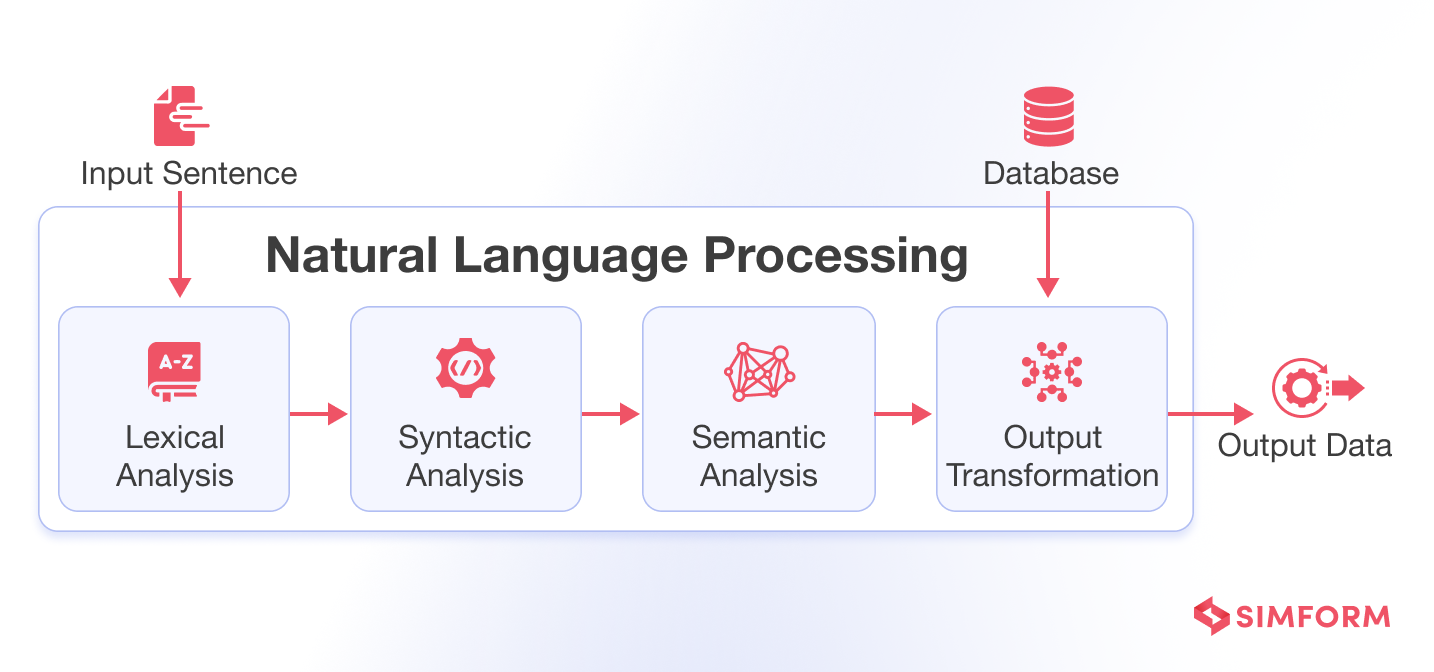The healthcare industry generates plenty of data from electronic health records, medical imaging, clinical notes, research papers, and even wearable devices. About 80% of this data is reportedly unstructured—including text, images, and audio—which makes it tough to get actionable insights with traditional data analysis methods.
Natural Language Processing (NLP) has emerged as a key tool, assisting machines in understanding both written and spoken human language, offering a powerful way to unlock the hidden value in these large data sets.
And it’s not only about data; NLP can enhance other aspects of healthcare, such as streamlining administrative tasks, improving patient communication, and aiding in predictive analytics and personalized medicine.
The global NLP market in healthcare and life sciences, valued at $4.78 billion in 2023, is expected to surge around $50.15 billion by 2033, growing at a CAGR of 26.4% from 2024 to 2033.
In this blog, we’ll explore different NLP techniques, the best applications of NLP in healthcare and life sciences, and the challenges associated with its implementation.
The relevance of Natural Language Processing in healthcare
NLP enables computers to understand, interpret, and respond to written and spoken human language. It bridges the gap between human communication and digital data processing and typically involves several stages:
- Lexical analysis – to break down the input text into words or small units called tokens
- Syntactic analysis – to understand grammatical structures
- Semantic analysis – to derive meaningful insights
Natural Language Processing in Electronic Health Records(EHRs)
Healthcare professionals maintain EHRs, digital versions of a patient’s medical history. EHRs contain various types of data, including –

As is visible, a significant portion of biomedical information is stored within EHRs. Physicians spend as much as 49% of their time on EHRs and desk work while being able to devote only 27% of their day to direct clinical patient care.
EHRs serve as a valuable source of research data. NLP can extract relevant information from clinical notes, such as symptoms, diagnoses, and treatment plans. With a comprehensive view of a patient’s medical history, healthcare professionals can identify trends, improve treatment outcomes, and advance medical research.
Aside from EHRs, NLP’s utility extends to a variety of other healthcare-related sources, including biomedical literature, social media platforms, news articles, reports, and open innovation contests.
Different NLP techniques you should know
NLP techniques can be used to structure and analyze this data, enabling better decision-making, clinical decision support, and healthcare facility assessment.

NLP techniques can be broadly categorized into three categories:
1. Rule-based techniques
These techniques rely on predefined rules and patterns to analyze and process text data. They are often used for tasks such as:
- Part-of-Speech (POS) tagging identifies grammatical categories of words in a sentence. For example, in “The patient reported severe chest pain,” “patient” is a noun, “reported” is a verb, etc.
- Named Entity Recognition (NER) identifies and classifies entities within text, such as names and medical terms. For instance, in “The patient John Smith reported severe chest pain,” “John Smith” is recognized as a person’s name, “chest” and “breath” as medical entities.
- Dependency parsing analyzes the grammatical structure by examining dependencies between phrases. For example, in “The patient reported severe chest pain,” it identifies relationships like subject-verb-object.
2. Statistical techniques
These techniques use ML algorithms to analyze and process text data.
- Supervised learning involves training models on labeled data to predict specific outcomes. For example, an ML model could be trained on a dataset of patient medical records to predict the likelihood of a heart attack based on symptoms like chest pain and shortness of breath reported by the patient.
- Unsupervised learning is about identifying patterns and relationships in unlabeled data. Here, clustering algorithms could be used to group patients with similar symptom profiles without any predefined labels, potentially uncovering new insights about disease subtypes.
- Deep learning involves using neural networks to analyze and process text data. Neural networks could be used to analyze free-text clinical notes and automatically extract relevant medical entities, relationships, and events to understand a patient’s condition comprehensively.
3. Hybrid techniques
These techniques combine rule-based and statistical methods to leverage the strengths of both approaches.
- Ensemble methods combine the predictions of multiple models to improve overall accuracy. For example, multiple NLP models (symptom extraction, diagnosis prediction, treatment recommendation) could be combined to improve the overall accuracy and robustness of the healthcare decision support system.
- Transfer learning involves using pre-trained models as a starting point (leveraging the knowledge and representations learned) and fine-tuning them for specific tasks. For instance, a pre-trained language model like BERT fine-tuned on a large corpus of medical text, could be used as a starting point to build specialized healthcare NLP applications, utilizing the model’s general understanding of language.
However, the categories mentioned above are not mutually exclusive. There are additional techniques covering a wide range of text processing and analysis capabilities.
- Optical Character Recognition (OCR): The process of extracting text from images or scanned documents.
- Sentiment analysis: The process of determining the emotional tone or sentiment expressed in a piece of text.
- Topic modeling: The process of discovering the main themes or topics present in a collection of text.
- Predictive analytics: Using NLP and machine learning techniques to make predictions based on text data.
Best applications of NLP In healthcare
Outstanding text processing and analysis capabilities make NLP suitable for use in various areas of healthcare, such as pharmaceuticals, healthcare providers, biotechnology, telemedicine, and more.
Here are the best applications:
1. Clinical documentation and records management
Clinical documents are important for effective care plans, but the manual, time-consuming, and complex documentation process is often prone to errors.
Management of Electronic Health Records
Let’s understand this with the example of progress notes. Physicians need to compile these notes daily for each patient. This involves manually documenting patient updates, such as changes in symptoms, new test results, and any changes in treatment plans.
Using NLP, an EHR system can automatically extract relevant information from dictations or typed notes.
For instance,
| An NLP engine can identify and structure key data points such as “HbA1c level dropped to 6.5%” or “patient reports reduced fatigue.” This data is then integrated into the relevant EHR fields without physician intervention. |
Unification of clinical records
NLP helps integrate data from various sources like patient history, lab results, imaging reports, and physician notes. This unification process involves identifying and linking related entities across different documents.
For example, the term “patient” in a doctor’s note could be linked to a name in the admission records, ensuring consistency in patient profiles.
The use of NLP-driven ontologies and taxonomies, such as UMLS (Unified Medical Language System), ensures that synonymous terms are standardized. For example,
Computer-Assisted Coding (CAC)
Medical coding is the process of assigning standard procedural and diagnostic codes to clinical documents. This coded data is important for billing, insurance claims processing, and analyzing healthcare trends.
Computer-Assisted Coding uses NLP and machine learning to analyze clinical documents and suggests proper medical codes for patient records. This involves semantic analysis and pattern recognition techniques.
For example,
NLP could identify phrases like “development of type 2 diabetes” and extract relevant details to allocate the correct code, thus ensuring billing accuracy and compliance.
2. Clinical decision support and research
Everyday, medical professionals need to make calculated decisions which naturally have important consequences, impacting patients on the individual level, local (community), national, or global level. Often, there’s not enough information, resources, or knowledge available. Yet these decisions are expected to be highly calculated and accurate.
| Clinical Decision Support Systems(CDSS) – “any software designed to directly aid in clinical decision making in which characteristics of individual patients are matched to a computerized knowledge base for the purpose of generating patient-specific assessments or recommendations that are then presented to clinicians for consideration.” |
NLP-powered CDSS can take data from the EHR and suggest potential diagnoses, treatment plans, and medication recommendations.
Medical research and literature analysis
Literature reviews are crucial in life sciences research for identifying gaps and unmet needs and guiding market strategies. Even regulatory agencies use them to create clinical guidelines and assess treatment impacts via methods like network meta-analysis.
However, traditional reviews are time-consuming and labor-intensive. NLP can streamline this process by:
- Automating literature searches to identify and summarize key studies.
- Synthesizing evidence to offer comprehensive insights and highlight research gaps.
- Summarizing lengthy papers into brief overviews for easy updates.
- Analyzing research to uncover emerging trends in medical studies.
Drug discovery
Developing a new drug takes a very long time and costs a lot of money, usually 10-15 years and over $1 billion. The real-world drug deployment process itself is quite intricate and full of practicalities and challenges.

- Clinical trial matching: About a third of clinical trials fail due to insufficient participant enrollment, with recruitment costs making up 32% of the budget. NLP can streamline this by automating patient data extraction from EHRs and matching it against trial eligibility, thus speeding up participant identification.
- Drug repurposing: NLP also accelerates drug repurposing by analyzing data to discover new uses for approved drugs, saving time and costs compared to developing new drugs from scratch.
- Drug and target interaction analysis: NLP platforms evaluate interactions between drugs, proteins, and disease pathways, aiding in understanding drug mechanisms and finding new therapeutic targets.
- Gene-disease mapping and protein interaction: NLP helps map genes to diseases and predict protein interactions by generating detailed embeddings from biomolecule texts, crucial for designing effective drugs and understanding biological targets.
| AstraZeneca and NVIDIA have developed a large transformer model, MegaMolBART. It can be used for a wide range of tasks, including molecular optimization, reaction prediction, and de novo molecule generation. |
3. Precision medicine and genomics
Precision medicine is about tailoring medical care to each patient’s specific characteristics. Central to this approach is genomics, which helps in understanding how differences in DNA affect health and disease. It provides critical insights into early signs of disease and individual risk levels for specific diseases.
However, the ability to sequence DNA outpaces our ability to interpret it, with genomic data growing faster than any other big data domain, doubling every 7 months. This data, distributed across multiple repositories and in different formats, requires robust tools for efficient and accurate knowledge extraction.
NLP techniques enable the automated extraction of clinically relevant information from the vast biomedical literature, such as gene-disease associations and drug-response variability, to support precision diagnosis, prognosis, and treatment planning. Additionally, NLP can parse clinical notes to identify patient phenotypes and link them to underlying genetic markers, facilitating the integration of multi-modal data for personalized medicine.
The ability to make sense of genomic data and uncover genomic differences can be very helpful with specific traits or diseases, such as cardiological, neurological, and immune-related conditions. By 2030, AI in the genomics sector is expected to hit $18 billion in accumulated revenue, growing at a CAGR of more than 50%.
4. AI medical scribe and chatbots
Speech recognition integrated with NLP helps physicians transcribe patient encounters in real-time. Virtual scribes can be quite helpful in a hectic ER environment. Physicians need to quickly document patient encounters while dealing with a high volume of cases, often leaving little time for detailed note-taking. Real-time transcription is also crucial for ensuring accuracy during virtual consultations in telehealth.
NLP-driven chatbots can answer queries about symptoms, medications, and appointments by understanding and processing natural language inputs. These chatbots often use sentiment analysis and intent recognition to deliver appropriate responses, improving patient engagement and satisfaction.
Tech giants like Google and Microsoft are developing virtual scribes using speech recognition to automate clinical documentation.
How did Simform build an AI-driven therapy bot?
One of our clients, MindFulMe, an innovative platform designed to cater to the critical mental health needs of university students, struggled to provide personalized and efficient mental health support. The reasons were limitations in counseling resources and access to qualified care.
- Simform developed an advanced therapy bot for context awareness and emotional intelligence, using Azure OpenAI GPT-3.5T and AWS Bedrock (Anthropic Claude 3 Sonnet).
- Amazon Transcribe and Amazon Comprehend streamlined clinical documentation automation, capturing students’ symptoms, progress, and treatment plans.
- Amazon SageMaker helped train AI models on patient data to identify high-risk students for mental health issues like depression or anxiety based on factors such as academic performance, social engagement, and self-reported symptoms.
Predictive disease modeling with SageMaker enabled MindFulMe to proactively provide personalized interventions and support to high-risk students.
5. Public health and surveillance
Here are some examples of how automated systematic review and analysis of valuable data from EHRs using NLP can help public health and surveillance:
- Identifying at-risk populations or conditions: By analyzing social media posts for keywords and sentiment, public health officials can pinpoint areas with high e-cigarette use among teenagers and target educational campaigns accordingly.
- Evaluating health interventions: NLP can monitor EHRs and news articles to assess the real-world effectiveness of new vaccination programs by tracking vaccination status and disease incidence.
- Generating and translating knowledge: NLP can extract insights from scientific articles about the link between air pollution and respiratory diseases, which can be used for public health advisories and policy recommendations.
- Detecting and mitigating critical events in real-time: During a foodborne illness outbreak, NLP can analyze social media and news reports to quickly identify the event’s location, symptoms, and suspected source, enabling rapid public health responses.
| Centers for Disease Control and Prevention (CDC) and Food and Drug Administration(FDA) developed an NLP web service which is publicly available to researchers to help them convert unstructured clinical information into structured data for public health use. |
What are the barriers to NLP adoption in healthcare?
Developing, deploying, and maintaining NLP systems in healthcare face significant financial and resource constraints due to high costs and shortages of skilled personnel. Then, there are industry-specific barriers and some stemming from the current limitations, like in evaluation and validation frameworks for these tools.
1. Linguistic complexity
Medical documentation can include synonyms, polysemy (words with multiple meanings), and homonyms (words that sound alike), which can confuse NLP systems.
For instance, “congestive heart failure” can also be referred to as “heart failure” or “CHF.” Similarly, the word “discharge” can imply either leaving a hospital or fluid coming from a wound.
Then,some expressions have multiple meanings. For example, “010202” could be – a date, a code, or just a number.
| Medical writing often breaks normal grammar rules and uses abbreviations that are hard to understand. For example, “c/o: fever” would mean “complaints of fever.” “Labs: K+ 4.1” would mean “Lab results: Potassium level is 4.1.” |
Data limitations
Medical data is naturally key for training NLP models, but there are many problems:
- Getting enough data is hard
- Privacy issues limit data sharing
- Hospitals keep records differently
- Data is often spread out in many places
- Medical notes use lots of shortcuts
- Some abbreviations have multiple meanings
These issues make it tough to organize and understand the data properly.
System integration
Integrating NLP within an organization’s IT infrastructure involves carefully considering various factors to ensure the selected solutions meet the specific business needs while seamlessly integrating with current systems. And when it is about healthcare, it is far from seamless.
First, medical records are stored in various formats and systems. Second, adapting existing workflows to accommodate NLP tools may disrupt established practices and require significant retraining of healthcare staff. And then, the technical barriers of inter-system operability can be daunting, often requiring custom solutions to ensure compatibility and efficiency.
Regulatory and compliance issues
Healthcare is heavily regulated. Any new technology, including NLP, must comply with strict laws and guidelines related to patient privacy and data security.
Regulatory frameworks like HIPAA in the U.S. impose rigorous standards for safeguarding medical data. Ensuring that NLP systems meet these regulations can be complex and time-consuming.
Since these regulations are subject to change, maintaining compliance over time adds another layer of difficulty to the adoption process.
The challenges that we discussed are surely not insurmountable. And we already know the potential of NLP in healthcare.
The key point to remember is— effective implementation requires collaboration between healthcare professionals and AI experts to ensure the technology addresses real-world needs.
Build innovative healthcare solutions with Simform
Simform, with over a decade of expertise, utilizes advanced machine learning and generative AI services to deliver tailored NLP solutions that effectively address healthcare challenges. We cater to the diverse needs of hospitals, clinics, pharmaceutical companies, health administrators, insurers, and medical laboratories. Our comprehensive portfolio includes telemedicine applications, clinical trial management systems, appointment scheduling software, hospital management software, telehealth solutions, and more.
We integrate powerful services like Amazon Comprehend Medical, which extracts critical medical information from unstructured clinical text, and AWS HealthScribe, which generates preliminary clinical notes from patient-clinician conversations. These services enhance efficiency, improve patient engagement, and ensure compliance with healthcare regulations.
Our approach combines advanced tools and industry expertise to deploy innovative healthcare solutions for our clients, ensuring a strong focus on security and patient care.

